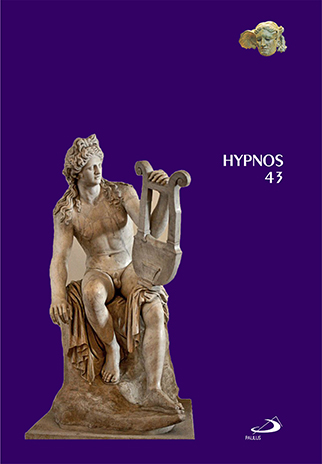ΣΥΜΒΟΛΑ, ΣΥΝΘΗΜΑΤΑ e ΕΙΚΏΝ: apontamentos sobre a relação dos símbolos teúrgicos e imagem no De Mysteriis de Jâmblico
Keywords:
Jâmblico, Teurgia, sÃmbolos, NeoplatonismoAbstract
No De Mysteriis, Jâmblico inova o uso dos termos symbolon e synthêma aplicando-os no contexto do ritual teúrgico para se referir a símbolos que habilitam uma conexão ontológica com o divino. Portanto, para compreender a defesa de Jâmblico da Teurgia é fundamental que se entenda o uso que ele faz desse vocabulário. Este artigo busca evidenciar se há na obra nuances que distinguam os termos symbolon e synthêma e em que medida os símbolos teúrgicos se articulam por meio de imagens e representações (εἰκόνας).References
ADDEY, C. Divination and Theurgy in Neoplatonism. Oracles of the Gods. Farnham UK; Burlington, VT: Ashgate, 2014.
FINAMORE, J. Iamblichean Dream Theory. In: BERCHMAN, R.M. (ed.). Mediators of the Divine: Horizons of Prophecy, Divination, Dreams and Theurgy in Mediterranean Antiquity. Atlanta, GA: Scholars Press, 1998, p.155–164.
GOMBRICH, E. H. Icones Symbolicae: The Visual Image in Neo-Platonic Thought. Journal of The Warburg and Courtauld Institutes, n.11, 1948, p.163-192.
JÂMBLICO. De Anima. Text, translation, and commentary by John F. Finamore and John M. Dillon. Leiden, Boston: Brill, 2002.
___________. De Mysteriis. Translated with an introduction by Emma C. Clarke, John M. Dillon and Jackson P. Hershbell. Leiden, Boston: Brill, 2004.
___________. Iamblichi Chalcidensis: In Platonis Dialogos commentariorum Fragmenta. Edited with translation and commentary by John M. Dillon. Leiden: Brill, 1973.
MANOLEA, Ch. Panagiota. Iamblichus on reason-principles. Parnassos, v.40, p.163–170, 1998.
SHAW, G. Theurgy and the Soul: The Neoplatonism of Iamblichus. University Park, Pennsylvania: Penn State University Press, 1995.
STRUCK, P. T. Birth of the Symbol: Ancient Readers at the Limits of Their Texts. Princeton: Princeton University Press, 2004.
Downloads
Published
Issue
Section
License
The contents of the manuscript have been tacitly or explicitly approved by the responsible authorities where the research was carried out.
Upon acceptation of the manuscript, the author agrees to allow its publication by Hypnos, declining pecuniary gains due from copyright. If the manuscript is published later in other media, the author agrees to always give credits of its first publication in Hypnos.
If the submitted document includes figures, tables, or large sections of text previously published, the author declares himself responsible for having obtained permission of the original copyright owners of these items for both the online and printed publication of this journal. Credits for copyrighted material must be properly attributed in the manuscript.


 A revista
A revista 